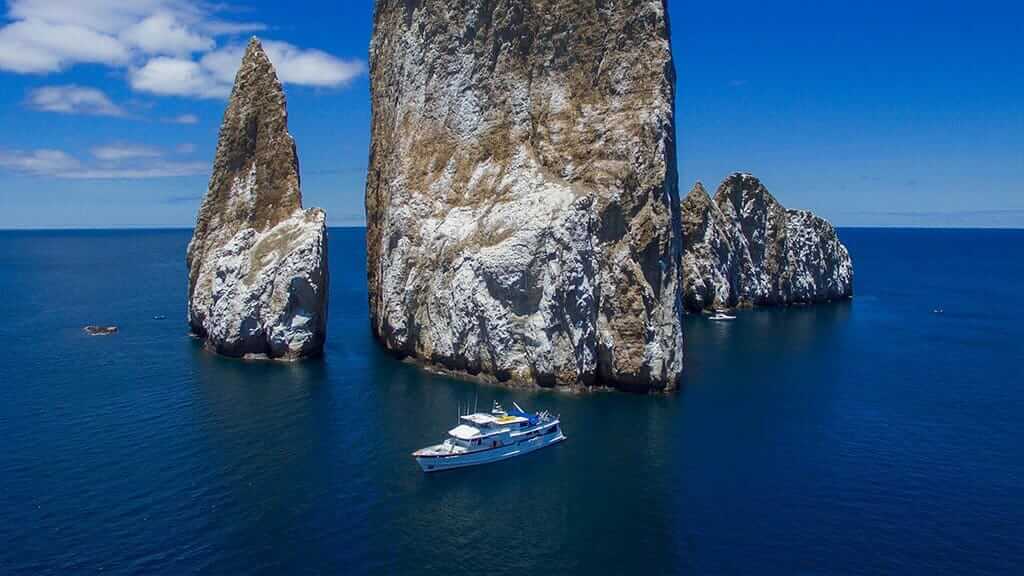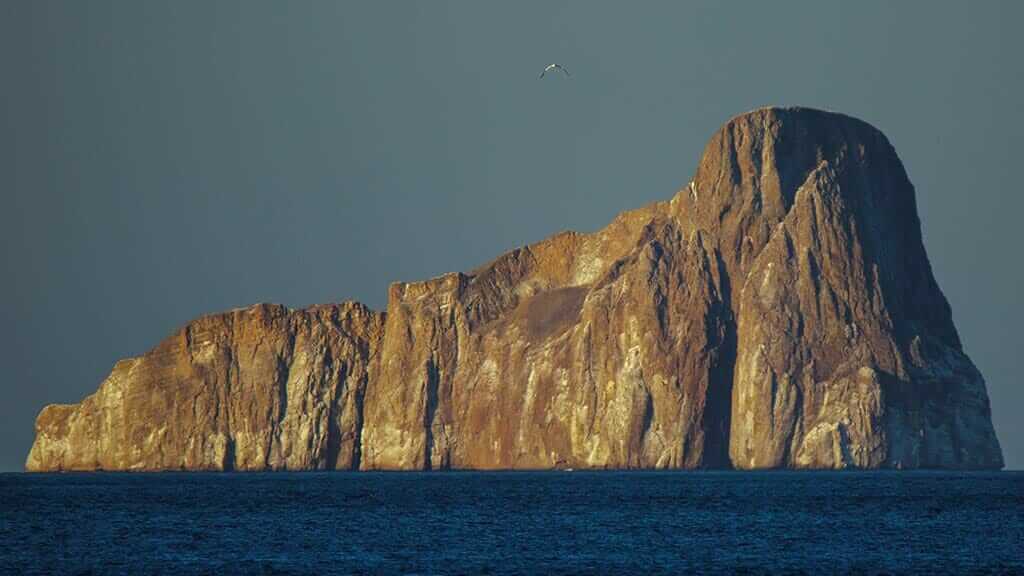Kicker Rock Galapagos (Leon Dormido)
Kicker Rock is one of the most iconic marine visitor sites at the Galapagos islands. For snorkelers & divers, this is a must-visit for a world-class underwater experience! Sharks, rays, sealions and colorful fish just love hanging out at this eroded volcanic cone. The vertical, sheer rock walls emerging from the ocean also make for breathtaking photos, especially at sunset. The best news of all? For tourists at San Cristobal island, Kicker rock is an easy and affordable visit to organise.
So, let’s check out how to make it happen. Keep Reading for everything you need to know about Kicker Rock Galapagos, and, most importantly, how to plan the perfect visit.
SECURE YOUR GALAPAGOS TRAVEL
Get a FREE personalised quote todayWhere is Kicker Rock?
Kicker Rock (also known as Leon Dormido) is found at San Cristobal island. San Cristobal is the oldest Galapagos island in geological terms, at the far south-eastern reaches of the archipelago.

From Puerto Baquerizo Moreno town, Kicker Rock is just over 17km to the north-east – aproximately 1 and ½ hour navigation by boat.

Why is Kicker Rock so famous?
Kicker Rock’s fame has always spread quickly by word of mouth among Galapagos travelers.
For starters, it’s one of the very best snorkelling sites of all Galapagos. Kicker Rock attracts both diversity and sheer quantity of marine creatures. It’s also THE place to snorkel safely with Galapagos sealions.
For a deeper immersion, don scuba gear and get closer to the Galapagos sharks, reef sharks, rays and sometimes even Scalloped hammerheads!
Kicker Rock is also one of the most frequently snapped landmarks at the Galapagos islands. At sunset in particular, the spectacular vertical cliffs glow in irresistable orange and pink hues – a photographers dream!
How to Visit Kicker Rock at Galapagos?
How to get to Kicker Rock?
Kicker Rock is a marine site, so the only access is by boat. The navigation from Puerto Baquerizo Moreno town takes around 1 & ½ hours each way.
There are various different ways for Galapagos tourists to visit Kicker Rock from town.
Kicker Rock day tours run 7 day a week, departing early in the morning. These trips last 6 hours (including the 3 hours travel time out and back). Expect about 3 hours of snorkeling time at both Kicker Rock and a secluded beach nearby. Day tours typically include an English-speaking naturalist guide, return boat transport, lunch and use of snorkelling gear.

There is also a longer 8-hour Kicker Rock 360 tour, looping all the way around San Cristobal island. Extra visits usually include Punta Pitt and Cerro Brujo, which makes for a long but rewarding day.
For island hoppers, a Kicker Rock day tour can easily be included into your land tour itinerary. Check out Happy Gringo’s popular 8-day Galapagos Explorer & 4-day San Cristobal Island Extension tours as examples.
Many Galapagos cruises also stop by Kicker Rock, but be sure to carefully check the yacht itinerary before booking.
Is it possible to visit Kicker Rock alone, without a Galapagos tour?
At time of writing, a guided tour is the only way to reach Kicker Rock. Due to it’s off-shore location, boat transport is a necessity. Also, an official guide must accompany groups for safety reasons.

GET FREE ADVICE
From a Galapagos destination expert todayThings to do at Kicker Rock
Kicker Rock Snorkeling
Kicker Rock is not your average calm Galapagos beach snorkelling site. We are talking a deep open-sea snorkel experience. That’s what makes Kicker Rock so exciting!
Deep sea currents push up against the exposed Kicker Rock vertical cliffs. This forces rich nutrients to the surface, forming the perfect feeding ground for marine species.
The best wildlife viewing is in the channel between the two exposed rocks, where the water is around 19meters (60 feet) deep. A good snorkelling strategy is to float around in this area, and see which creatures cross your path. There’s no need to swim hard or go chasing after animals. Strong swimmers might also like to check out the rougher waters outside of the channel.

What wildlife to expect when snorkelling at Kicker Rock? Whitetip reef and Galapagos sharks are both common sightings. Hammerheads also occasionally cruise through. Groups of rays (especially spotted eagle and golden rays) also love this area, as do sealions, marine iguana and sea turtles.
Tropical reef fish are also abundant, often including (but not limited to) yellowtail surgeonfish, parrotfish, Mexican hogfish, Sergeant major fish, pufferfish, hawkfish and rainbow wrasse. Other interesting Kicker Rock species include barracuda, eel and octopus.

Kicker Rock diving
To get even closer to the spectacular marine action, book a dive day tour, with two immersions included at different areas of Kicker Rock. Due to the strong currents in open water, this is a scuba site suited to intermediate and advanced divers.
Is kicker rock diving better than snorkelling? To get up closer to the sharks, and increase the chances of a hammerhead sighting, most divers would agree that it’s worth the extra expense. Having said that though, Kicker rock snorkeling is also breathtaking, so it really depends on individual taste.
Kicker Rock Bird Watching
Galapagos bird species are also attracted in large numbers to Kicker Rock. Nazca and blue footed boobies dive bomb to catch fish, while Frigates try to scavenge their catch. The beautiful red billed Tropicbird can also sometimes be spotted. Before jumping into the water, be sure to take a good look along the cliffs for nesting sites of all these birds, and more.
Kicker Rock Beach
Although Kicker Rock itself has no beach site, day tours do include a stop at a nearby, secluded beach on San Cristobal island. Here, day trippers can choose between sunbathing, beach-combing, or snorkeling in the shallows.
Practicalities for visiting Kicker Rock Galapagos
- Marine life at Kicker Rock is more abundant and active from May to November/December (cool & dry season). During these months the water is colder, and richer in nutrients, attracting more wildlife. Wetsuits are recommended in this season to stay warm in the sea.
- From December through to April/May (warm & wet season) visitors won’t be disappointed either. There is always lots of underwater action at Kicker Rock, and the sea will be warmer.
- Kicker Rock Galapagos is only suitable for confident swimmers. The currents here are strong, especially so during the cool & dry season. Do not underestimate the risks in open sea.
- Recommended items to to bring along: treking or regular sandals, swimwear, towel, change of clothes, light jacket, sun protection (sunglasses, hat, sunblock), water bottle, underwater camera / cellphone.
Fun Kicker Rock Facts
Why is it called kicker rock?
When viewed from the north, it is said that the eroded rock formation resembles a shoe. Hence the name “kicker” rock.

Why is it’s Spanish name Leon Dormido?
From a southern perspective, locals say the rock looks more like a sleeping sea lion. Leon dormido translates to English as “sleeping lion”.
As is often the case when looking for animal or shoe shapes in mountains, a little imagination is often required.
How deep is the water at kicker rock?
The sea depth at Kicker Rock ranges from 30 to 130 feet. Snorkellers will swim through the small 70 foot channel, where the water depth averages 60 feet.

How big is Kicker Rock?
The cliffs of Kicker Rock rise almost 153 meters (500 feet) from the ocean floor.

Why are so many sharks attracted to kicker rock?
When deep sea and strong currents come into contact with vertical rock, the conditions are perfect to force rich nutrients to the surface. This creates the perfect feeding ground to attract sharks and other marine species. It also explains the abundance of marine bird nests found on the cliffs.

How did Kicker Rock form?
Kicker Rock is the remains of a volcanic tuff cone. In fact the cliffs are not made of rock, rather densely compacted volcanic ash.

Book with The #1 Trusted
Galapagos Travel Agency
Contact us to organise a Galapagos vacation that includes an unforgettable visit to Kicker Rock. We’ll be happy to send you a free tour quote, with all of the very best Galapagos options for your dream trip.
In conclusion, Kicker Rock Galapagos is a must-visit for keen snorkellers and scuba divers. The marine life here is truly world-class, and one of the very best Galapagos sites of all to jump into the sea. Sharing the water with sea lions, sharks and rays makes for some epic ticks to any bucket list. It’s also easy to visit as part of a cruise, or as a day tour from San Cristobal island. Happy Gringo highly recommend to include Kicker Rock into your Galapagos itinerary.











